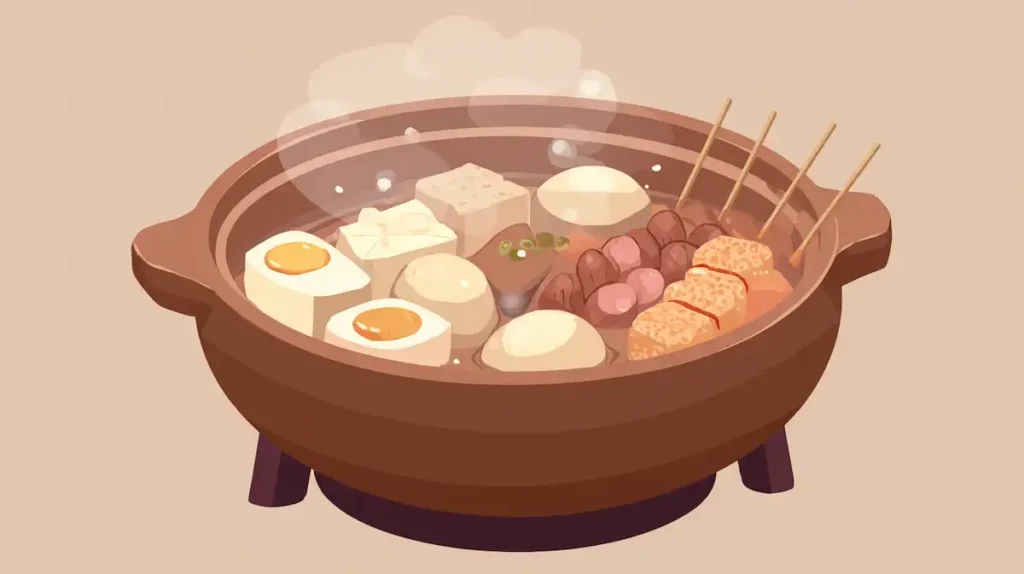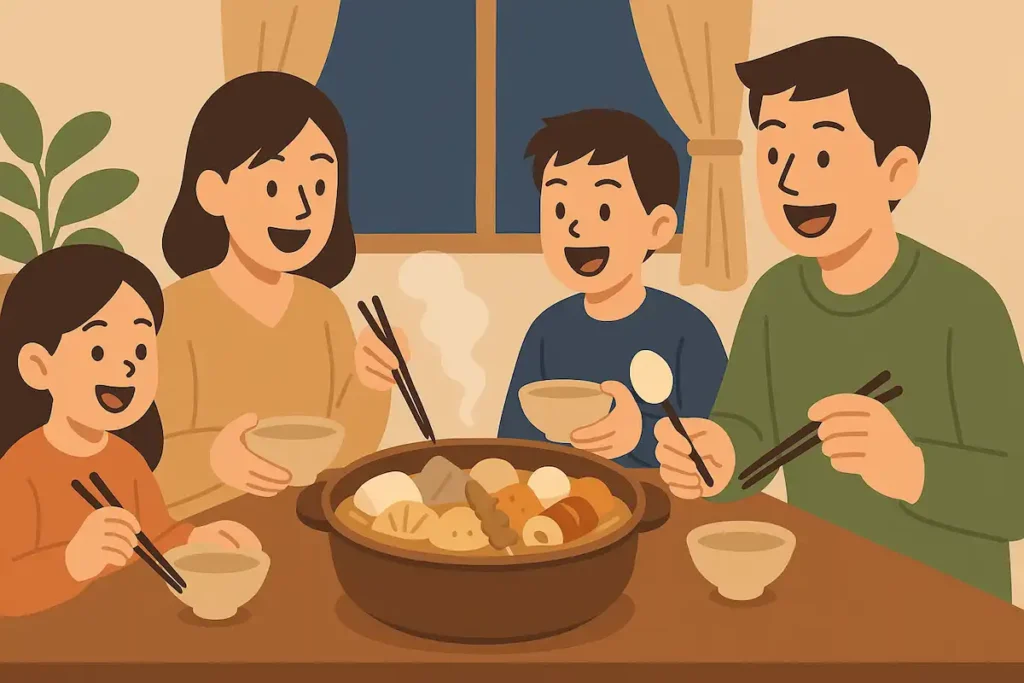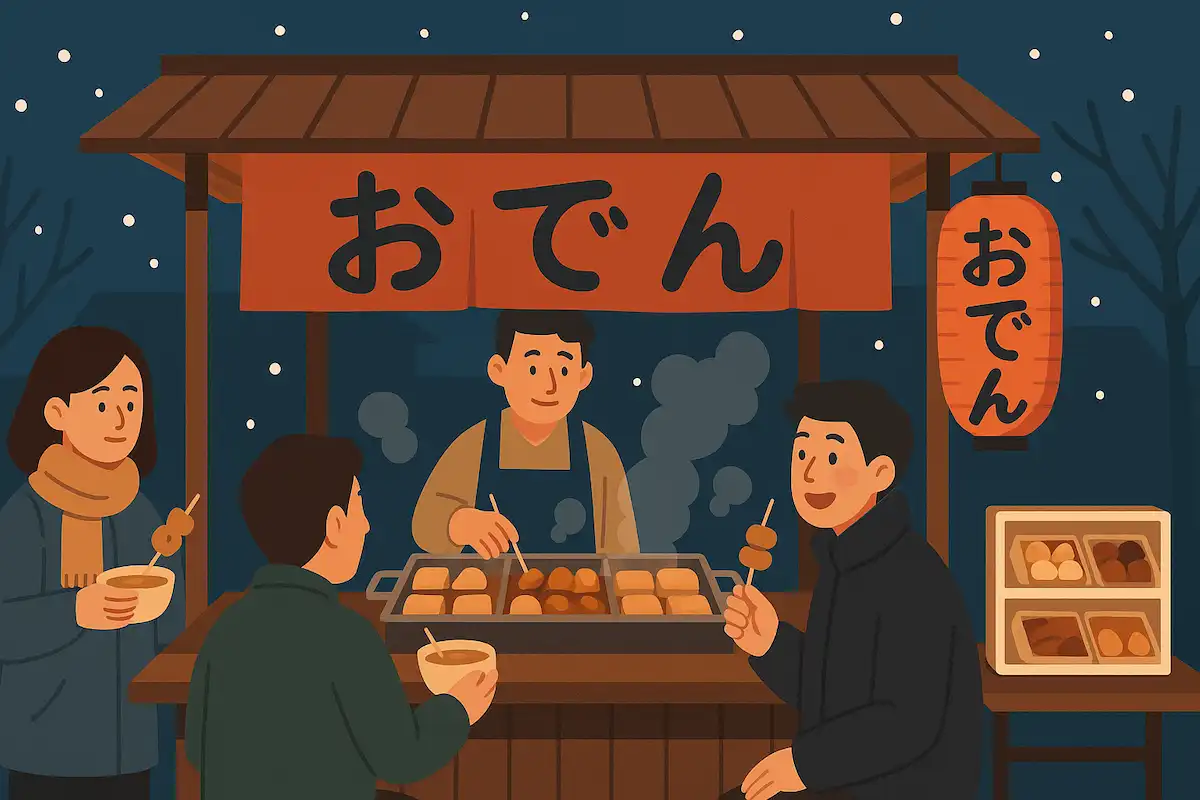おでんを英語で説明・紹介するための基本情報と、英会話に役立つ表現をシンプルでわかりやすい英語で紹介します。
英会話ダイアローグ・概要・10の質問を通して、おでんに関する英語表現を学びます。
英語
英会話ダイアローグを読む前に知っておくと良い前提知識と情報です。
- おでんとは
- 冬の定番料理で、だし汁に大根・卵・こんにゃく・練り物などを入れて煮込む
- 体が温まる庶民的な鍋料理として親しまれている
- 起源と歴史
- 江戸時代に豆腐田楽(豆腐に味噌を塗って焼いた料理)がもとになり、後に煮込みスタイルに発展明治以降、日本全国に広まった
- 地域ごとの違い
- 関東:濃口醤油で黒っぽいだし
- 関西:薄口醤油で澄んだ上品なだし
- 名古屋:八丁味噌を使った「味噌おでん」
- 静岡:黒いだし+串刺し、青のりや削り粉をかける
- 定番の具材
- 大根、卵、こんにゃく、豆腐、ちくわやはんぺんなどの練り物
- 牛すじ、餅巾着、ロールキャベツなど地域や家庭によって多彩
- 魅力と人気の理由
- だしがしみ込む「しみしみ」のおいしさ
- 家でも外でも食べられる手軽さ 体も心も温める“ソウルフード”的存在
- コンビニおでん
- 以前はレジ横の大鍋が定番だったが、衛生面から減少傾向
- 最近は真空パックやレトルトタイプの商品が増えている
2人が「おでん」について話しています。
おでんの歴史や地域ごとの違い、定番具材や人気の理由、コンビニでの販売スタイルなどを話題にしています。
会話 / dialogue

Hey Key, lately I’ve been curious about Japanese winter food. I often hear people talking about oden. Do you like it?

Absolutely, Mack. Oden is one of the most popular hotpot dishes in Japan, especially in autumn and winter.

So what exactly is it? I only know it’s something simmered in soup.

You’re right. Oden is a dish where different ingredients are slowly simmered in a soy-flavored dashi broth made from kombu and bonito.

That sounds comforting. What’s the history behind it?

It actually started in the Edo period. At first, people grilled tofu with miso, called “dengaku.” Later, it developed into a simmered dish, and it spread all over Japan.

Interesting! Are there regional differences?

Yes, big ones. In Kanto, the broth is dark with strong soy sauce. In Kansai, it’s lighter and clearer. Nagoya has miso oden, and Shizuoka oden is famous for its black broth and skewers.

Wow, that means I could try a different style depending on the city I visit.

Exactly. Each area gives you a new experience of the same dish.

What are the most common ingredients?

Daikon radish is the star, along with boiled eggs, konnyaku, tofu, and fishcakes. Some people love beef tendon, mochi pouches, or even cabbage rolls.

Daikon in broth must taste amazing.

Yes, we call it “shimi-shimi.” It means the broth soaks deep inside the daikon, making it juicy and flavorful.

That sounds like the charm of oden.

Exactly. Its simple but deep taste is what makes it so special.

Do people usually eat it at home or outside?

Both. Families cook it at home in winter, but you can also enjoy it in izakaya pubs, food stalls, and even at convenience stores.

Convenience stores? Really?

Yes. In winter, you’ll see a big oden pot near the cashier where you can choose your favorite items.

But recently, many stores also sell oden in sealed packs for hygiene reasons. It’s easy to take home and heat up.

That’s so practical! No wonder it’s popular.

Exactly. It’s loved by children, adults, and even older people. Everyone has their own favorite ingredients.

I see. So oden is not only tasty but also brings people together.

That’s true. It warms both the body and the heart. For Japanese people, it’s almost like soul food in winter.

Thanks, Key. Now I really want to try oden, maybe start with daikon and an egg.

Great choice! Once you taste it, you’ll understand why it’s so beloved in Japan.
概要(おでんの魅力と特徴)
「おでん」について、理解を深めるための「英語での概要」です。
おでん

What is Oden?
Oden is a traditional Japanese hotpot dish that is very popular in autumn and winter. It is made by slowly simmering different ingredients in a light soy-flavored broth. The soup base is usually prepared with kombu seaweed and bonito flakes, and then seasoned with soy sauce and mirin. The taste is gentle but full of umami, and it warms the body during the cold season.
History of Oden
The history of oden goes back to the Edo period. At first, people enjoyed a dish called dengaku, which was tofu grilled with miso. Later, people started simmering many different items together in broth, and this style spread throughout Japan. Over time, each region developed its own way of making oden, and it became one of Japan’s favorite winter foods.
Ingredients and Variety
Oden has many ingredients to choose from. The most common are daikon radish, boiled eggs, konnyaku, tofu, and fishcakes. Some people enjoy beef tendon, mochi pouches, or even cabbage rolls. Each person can pick their own favorites, which makes oden fun for families and groups. In Kanto, the broth is dark with strong soy sauce, while Kansai oden has a lighter, clearer soup. In Nagoya, people eat miso oden, and in Shizuoka, oden is served with a black broth and skewers.
Oden Today
Oden is cooked at home, enjoyed at izakaya pubs and food stalls, and also sold in convenience stores. In the past, big pots were placed near the cashier, but today many shops also sell oden in sealed packs for hygiene reasons. Oden is loved by all generations. It is not only tasty but also comforting, making it a true Japanese soul food in winter.
10の質問(おでんの基本知識)
「おでん」について、理解を深めるための「英語での10の質問」です。
1: What is oden?
Oden is a Japanese hotpot dish where many ingredients are simmered in a light soy-flavored broth. It is popular in autumn and winter.
2: When did oden start?
Oden started in the Edo period. At first, people ate grilled tofu with miso called dengaku, and later it became a simmered dish.
3: What is the main flavor of oden broth?
The broth is usually made from kombu seaweed and bonito flakes, with soy sauce and mirin added.
4: Are there regional differences in oden?
Yes. In Kanto, the broth is dark with strong soy sauce. In Kansai, it is lighter. Nagoya has miso oden, and Shizuoka has oden with black broth and skewers.
5: What are the most common oden ingredients?
The most common ingredients are daikon radish, boiled eggs, konnyaku, tofu, and fishcakes.
6: What is special about daikon in oden?
Daikon absorbs the broth deeply. It becomes soft, juicy, and very flavorful.
7: Where can people eat oden?
People can eat oden at home, in izakaya pubs, at food stalls, and in convenience stores.
8: Do convenience stores still sell oden?
Yes, but today many stores sell oden in sealed packs for hygiene reasons, not only in pots near the cashier.
9: Why is oden popular?
Oden is popular because it is warm, tasty, and easy to share. It is loved by people of all ages.
10: What makes oden a special dish in Japan?
Oden is special because it is simple but full of umami. It warms both the body and the heart, so it is called a Japanese soul food.

和訳付
会話 / dialogue

Hey Key, lately I’ve been curious about Japanese winter food. I often hear people talking about oden. Do you like it?
ねえキー、最近日本の冬の食べ物に興味があってさ。よく「おでん」の話を聞くんだけど、好き?

Absolutely, Mack. Oden is one of the most popular hotpot dishes in Japan, especially in autumn and winter.
もちろん好きだよ、マック。おでんは日本で一番人気のある鍋料理のひとつで、特に秋から冬にかけてよく食べられるんだ。

So what exactly is it? I only know it’s something simmered in soup.
で、具体的にはどんな料理なの?スープで煮込んでるってことしか知らないんだけど。

You’re right. Oden is a dish where different ingredients are slowly simmered in a soy-flavored dashi broth made from kombu and bonito.
その通り。おでんは、昆布とかつおで取っただしに醤油を加えて、その中でいろんな具材をじっくり煮込んだ料理なんだ。

That sounds comforting. What’s the history behind it?
なんだかホッとする感じだね。歴史はどんなふうに始まったの?

It actually started in the Edo period. At first, people grilled tofu with miso, called “dengaku.” Later, it developed into a simmered dish, and it spread all over Japan.
実は江戸時代に始まったんだ。最初は豆腐に味噌を塗って焼いた「田楽」って料理だったんだけど、やがて煮込みスタイルに発展して、日本中に広がったんだよ。

Interesting! Are there regional differences?
へぇ、面白いね!地域ごとに違いはあるの?

Yes, big ones. In Kanto, the broth is dark with strong soy sauce. In Kansai, it’s lighter and clearer. Nagoya has miso oden, and Shizuoka oden is famous for its black broth and skewers.
うん、大きな違いがあるよ。関東は濃口醤油で黒っぽいだし、関西は薄口醤油で澄んだだし。名古屋は味噌おでん、静岡は黒いスープで串に刺さったおでんが有名なんだ。

Wow, that means I could try a different style depending on the city I visit.
すごい!じゃあ行く場所によって違うスタイルを楽しめるんだね。

Exactly. Each area gives you a new experience of the same dish.
その通り。同じおでんでも地域ごとに新しい体験ができるんだ。

What are the most common ingredients?
一番よく入っている具材って何?

Daikon radish is the star, along with boiled eggs, konnyaku, tofu, and fishcakes. Some people love beef tendon, mochi pouches, or even cabbage rolls.
主役は大根だね。他にはゆで卵、こんにゃく、豆腐、練り物。牛すじや餅巾着、ロールキャベツを好む人もいるよ。

Daikon in broth must taste amazing.
だしを吸った大根って絶対おいしいよね。

Yes, we call it “shimi-shimi.” It means the broth soaks deep inside the daikon, making it juicy and flavorful.
そうなんだよ。「しみしみ」って呼んでて、だしが中までしっかり染みてジューシーで旨いんだ。

That sounds like the charm of oden.
それがおでんの魅力って感じだね。

Exactly. Its simple but deep taste is what makes it so special.
そうそう。シンプルだけど味わい深いところが特別なんだよ。

Do people usually eat it at home or outside?
おでんって、家で食べるの?それとも外で?

Both. Families cook it at home in winter, but you can also enjoy it in izakaya pubs, food stalls, and even at convenience stores.
どっちもだね。冬は家庭で作るし、居酒屋や屋台、コンビニでも楽しめるよ。

Convenience stores? Really?
コンビニ?ほんとに?

Yes. In winter, you’ll see a big oden pot near the cashier where you can choose your favorite items.
そうなんだ。冬になるとレジの近くに大きなおでん鍋があって、好きな具材を選べるんだよ。

But recently, many stores also sell oden in sealed packs for hygiene reasons. It’s easy to take home and heat up.
でも最近は、衛生面の理由でパック詰めのおでんを売る店も増えてるんだ。持ち帰って温めるだけで食べられて便利だよ。

That’s so practical! No wonder it’s popular.
めっちゃ便利だね!そりゃ人気になるわけだ。

Exactly. It’s loved by children, adults, and even older people. Everyone has their own favorite ingredients.
そうそう。子どもから大人、お年寄りまでみんなに愛されてて、それぞれお気に入りの具があるんだ。

I see. So oden is not only tasty but also brings people together.
なるほど。おでんはおいしいだけじゃなく、人をつなげてくれる料理なんだね。

That’s true. It warms both the body and the heart. For Japanese people, it’s almost like soul food in winter.
その通り。体も心も温めてくれる。日本人にとっては冬のソウルフードみたいなものなんだよ。

Thanks, Key. Now I really want to try oden, maybe start with daikon and an egg.
ありがとう、キー。ますます食べたくなったよ。まずは大根と卵から挑戦してみようかな。

Great choice! Once you taste it, you’ll understand why it’s so beloved in Japan.
いいチョイスだね!一度食べたら、どうして日本でそんなに愛されてるのか分かると思うよ。
概要(おでんの魅力と特徴)
おでん

What is Oden?
Oden is a traditional Japanese hotpot dish that is very popular in autumn and winter. It is made by slowly simmering different ingredients in a light soy-flavored broth. The soup base is usually prepared with kombu seaweed and bonito flakes, and then seasoned with soy sauce and mirin. The taste is gentle but full of umami, and it warms the body during the cold season.
おでんは、日本の伝統的な鍋料理で、秋や冬にとても人気があります。昆布やかつお節で取っただしに醤油やみりんを加えたスープで、さまざまな具材をじっくり煮込んで作ります。味は優しいながらも旨みがたっぷりで、寒い季節に体を温めてくれる料理です。
History of Oden
The history of oden goes back to the Edo period. At first, people enjoyed a dish called dengaku, which was tofu grilled with miso. Later, people started simmering many different items together in broth, and this style spread throughout Japan. Over time, each region developed its own way of making oden, and it became one of Japan’s favorite winter foods.
おでんの歴史は江戸時代にさかのぼります。最初は「田楽」と呼ばれる豆腐に味噌を塗って焼いた料理が楽しまれていました。その後、さまざまな具材をだしで煮込むスタイルが広がり、日本中に広まっていきました。やがて地域ごとに独自のスタイルが生まれ、おでんは日本の冬の定番料理となったのです。
Ingredients and Variety
Oden has many ingredients to choose from. The most common are daikon radish, boiled eggs, konnyaku, tofu, and fishcakes. Some people enjoy beef tendon, mochi pouches, or even cabbage rolls. Each person can pick their own favorites, which makes oden fun for families and groups. In Kanto, the broth is dark with strong soy sauce, while Kansai oden has a lighter, clearer soup. In Nagoya, people eat miso oden, and in Shizuoka, oden is served with a black broth and skewers.
おでんには選べる具材がたくさんあります。もっとも一般的なのは、大根、ゆで卵、こんにゃく、豆腐、練り物です。牛すじや餅巾着、ロールキャベツを好む人もいます。好きな具材を自由に選べるので、家族や友人で食べるときに楽しい料理です。関東では濃口醤油で色の濃いだし、関西では薄口醤油で澄んだ上品なだしが特徴です。名古屋では味噌おでん、静岡では黒いだしと串に刺さったおでんが有名です。
Oden Today
Oden is cooked at home, enjoyed at izakaya pubs and food stalls, and also sold in convenience stores. In the past, big pots were placed near the cashier, but today many shops also sell oden in sealed packs for hygiene reasons. Oden is loved by all generations. It is not only tasty but also comforting, making it a true Japanese soul food in winter.
おでんは家庭で作られるほか、居酒屋や屋台でも楽しめ、コンビニでも販売されています。以前はレジ横に大きな鍋が置かれていましたが、最近では衛生面を考えてパック詰めの商品を売る店も増えています。おでんは世代を問わず愛される料理で、おいしいだけでなく心も温めてくれる、日本の冬のソウルフードです。
10の質問(おでんの基本知識)
1: What is oden?
おでんとは何ですか?
Oden is a Japanese hotpot dish where many ingredients are simmered in a light soy-flavored broth. It is popular in autumn and winter.
おでんは、さまざまな具材を醤油風味のだしで煮込む日本の鍋料理です。秋から冬にかけて人気があります。
2: When did oden start?
おでんはいつ始まりましたか?
Oden started in the Edo period. At first, people ate grilled tofu with miso called dengaku, and later it became a simmered dish.
おでんは江戸時代に始まりました。最初は「田楽」と呼ばれる味噌を塗って焼いた豆腐でしたが、後に煮込み料理へと発展しました。
3: What is the main flavor of oden broth?
おでんのだしの主な味は何ですか?
The broth is usually made from kombu seaweed and bonito flakes, with soy sauce and mirin added.
だしは通常、昆布とかつお節から作られ、醤油とみりんで味を調えます。
4: Are there regional differences in oden?
おでんには地域による違いがありますか?
Yes. In Kanto, the broth is dark with strong soy sauce. In Kansai, it is lighter. Nagoya has miso oden, and Shizuoka has oden with black broth and skewers.
はい。関東は濃口醤油で黒っぽいだし、関西は薄口で澄んだだしです。名古屋には味噌おでんがあり、静岡では黒いだしと串刺しのおでんが有名です。
5: What are the most common oden ingredients?
おでんの最も一般的な具材は何ですか?
The most common ingredients are daikon radish, boiled eggs, konnyaku, tofu, and fishcakes.
もっとも一般的な具材は、大根、ゆで卵、こんにゃく、豆腐、そして練り物です。
6: What is special about daikon in oden?
おでんの大根は何が特別ですか?
Daikon absorbs the broth deeply. It becomes soft, juicy, and very flavorful.
大根はだしを深く吸い込み、柔らかくジューシーでとても味わい深くなります。
7: Where can people eat oden?
人々はどこでおでんを食べられますか?
People can eat oden at home, in izakaya pubs, at food stalls, and in convenience stores.
おでんは家庭のほか、居酒屋、屋台、そしてコンビニでも食べられます。
8: Do convenience stores still sell oden?
コンビニでは今もおでんを売っていますか?
Yes, but today many stores sell oden in sealed packs for hygiene reasons, not only in pots near the cashier.
はい。しかし最近はレジ横の鍋だけでなく、衛生面を考えてパック詰めで販売する店が多いです。
9: Why is oden popular?
なぜおでんは人気があるのですか?
Oden is popular because it is warm, tasty, and easy to share. It is loved by people of all ages.
おでんは体を温め、おいしく、みんなで分け合いやすいから人気があります。子どもから大人まで幅広く愛されています。
10: What makes oden a special dish in Japan?
おでんが日本で特別な料理であるのはなぜですか?
Oden is special because it is simple but full of umami. It warms both the body and the heart, so it is called a Japanese soul food.
おでんはシンプルなのに旨みがたっぷりで、体も心も温めてくれるので、日本のソウルフードと呼ばれています。

words & phrases
英会話ダイアローグと関連情報に出てきた単語・フレーズです(例文は各3つ)。

simmered : 動詞(過去分詞・形容詞的用法) /ˈsɪm.ərd/
意味: 弱火でじっくり煮込んだ。Cooked gently in liquid at a low temperature.
(おでんの具材がだしで長時間煮込まれていることを指す)
例文:
- The vegetables were simmered in broth for hours.
「野菜は何時間もだしで煮込まれていました。」 - This soup tastes better when simmered slowly.
「このスープはゆっくり煮込むともっとおいしくなります。」 - The fish was simmered with soy sauce and sugar.
「魚は醤油と砂糖で煮付けられました。」
comforting : 形容詞 /ˈkʌm.fə.tɪŋ/
意味: 心を落ち着ける、安心させる。Making you feel relaxed, safe, or less worried.
(おでんが体も心も温めて安心感を与える料理であることを指す)
例文:
- A hot bowl of soup is very comforting on a cold day.
「寒い日には熱いスープがとても心を和ませます。」 - Her words were comforting after the bad news.
「悪い知らせを聞いた後、彼女の言葉はとても慰めになりました。」 - The smell of fresh bread is always comforting.
「焼きたてのパンの香りはいつも安心感を与えます。」
skewer : 名詞 /ˈskjuː.ər/
意味: 串、または串に刺すこと。A long stick used to hold pieces of food together while cooking.
(静岡おでんで具材が串に刺さっていることを指す)
例文:
- The meat was grilled on a skewer.
「肉は串に刺して焼かれました。」 - She put vegetables on a skewer for the barbecue.
「彼女はバーベキュー用に野菜を串に刺しました。」 - In Shizuoka, oden items are served on a skewer.
「静岡ではおでんの具材が串に刺されて提供されます。」
beef tendon : 名詞句 /ˌbiːf ˈten.dən/
意味: 牛すじ肉。The tough connective tissue from beef, often cooked until soft.
(おでんの人気具材のひとつで、長時間煮込むことで柔らかく味わい深くなる部分を指す)
例文:
- Beef tendon becomes soft after long cooking.
「牛すじは長く煮込むと柔らかくなります。」 - Many people enjoy beef tendon in hotpot dishes.
「多くの人が鍋料理で牛すじを楽しみます。」 - Oden often includes beef tendon on skewers.
「おでんにはよく串に刺した牛すじが入っています。」
beloved : 形容詞 /bɪˈlʌv.ɪd/ または /bɪˈlʌvd/
意味: 愛されている、大切にされている。Dearly loved, cherished, or very popular.
(おでんが日本人に長く愛され続けている料理であることを指す)
例文:
- Oden is a beloved winter dish in Japan.
「おでんは日本で愛されている冬の料理です。」 - The teacher was beloved by all her students.
「その先生は生徒全員から愛されていました。」 - This old park is a beloved place in the town.
「この古い公園は町で大切にされている場所です。」
